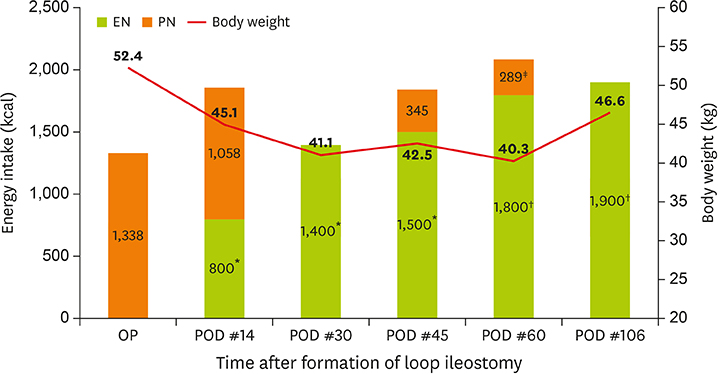Clin Nutr Res.
2019 Jul;8(3):247-253. 10.7762/cnr.2019.8.3.247.
Nutritional Management of a Patient with a High-Output Stoma after Extensive Small Bowel Resection to Treat Crohn's Disease
- Affiliations
-
- 1Department of Food Service and Nutrition Care, Seoul National University Hospital, Seoul 03080, Korea. msp63@snuh.org
- KMID: 2454082
- DOI: http://doi.org/10.7762/cnr.2019.8.3.247
Abstract
- For patients with short bowel syndrome who undergo ileostomy, nutritional management is essential to prevent complications associated with a high-output stoma (HOS). We report a practical example of ostomic, medical nutrition therapy provided by an intensive nutritional support team (NST). A 42-year-old male with a history of Crohn's disease visited Seoul National University Hospital for treatment of mechanical ileus. He underwent loop ileostomy after extensive small bowel resection. As his remaining small bowel was only 160 cm in length, the stomal output was about 3,000 mL/day and his body weight fell from 52.4 to 40.3 kg. Given his clinical condition, continuous tube feeding for 24 h was used to promote adaptation of the remnant bowel. Thereafter, an oral diet was initiated and multiple, nutritional educational sessions were offered by dietitians. Constant infusion therapy was prescribed and included in the discharge plan. Two months after discharge, his body weight had increased to 46.6 kg and his hydration status was appropriately maintained. This case suggests that the critical features of medical nutritional therapy for ostomy management are frequent assessments of fluid balance, weight history, and laboratory data and after nutritional interventions.
MeSH Terms
Figure
Reference
-
1. Baker ML, Williams RN, Nightingale JM. Causes and management of a high-output stoma. Colorectal Dis. 2011; 13:191–197.
Article2. Nightingale J, Woodward JM; Small Bowel and Nutrition Committee of the British Society of Gastroenterology. Guidelines for management of patients with a short bowel. Gut. 2006; 55:Suppl 4. iv1–12.
Article3. Mountford CG, Manas DM, Thompson NP. A practical approach to the management of high-output stoma. Frontline Gastroenterol. 2014; 5:203–207.
Article4. Arenas Villafranca JJ, López-Rodríguez C, Abilés J, Rivera R, Gándara Adán N, Utrilla Navarro P. Protocol for the detection and nutritional management of high-output stomas. Nutr J. 2015; 14:45.
Article5. Wall EA. An overview of short bowel syndrome management: adherence, adaptation, and practical recommendations. J Acad Nutr Diet. 2013; 113:1200–1208.
Article6. United Ostomy Associations of America. Ostomy nutrition guide. Kennebunk (ME): United Ostomy Associations of America;2017.7. Thompson JS, Iyer KR, DiBaise JK, Young RL, Brown CR, Langnas AN. Short bowel syndrome and Crohn's disease. J Gastrointest Surg. 2003; 7:1069–1072.
Article8. American Society for Parenteral and Enteral Nutrition. The ASEPEN adult nutrition support core curriculum. 3rd ed. Silver Spring (MD): American Society for Parenteral and Enteral Nutrition;2017.9. McClave SA, Taylor BE, Martindale RG, Warren MM, Johnson DR, Braunschweig C, McCarthy MS, Davanos E, Rice TW, Cresci GA, Gervasio JM, Sacks GS, Roberts PR, Compher C. Society of Critical Care Medicine. American Society for Parenteral and Enteral Nutrition. Guidelines for the provision and assessment of nutrition support therapy in the adult critically ill patient: Society of Critical Care Medicine (SCCM) and American Society for Parenteral and Enteral Nutrition (A.S.P.E.N). JPEN J Parenter Enteral Nutr. 2016; 40:159–211.
Article10. Bernell O, Lapidus A, Hellers G. Risk factors for surgery and postoperative recurrence in Crohn's disease. Ann Surg. 2000; 231:38–45.
Article11. Matarese LE, Jeppesen PB, O'Keefe SJ. Short bowel syndrome in adults: the need for an interdisciplinary approach and coordinated care. JPEN J Parenter Enteral Nutr. 2014; 38:60S–64S.12. Tsao SK, Baker M, Nightingale JM. High-output stoma after small-bowel resections for Crohn's disease. Nat Clin Pract Gastroenterol Hepatol. 2005; 2:604–608.
Article13. Winkler MF, Smith CE. Clinical, social, and economic impacts of home parenteral nutrition dependence in short bowel syndrome. JPEN J Parenter Enteral Nutr. 2014; 38:32S–37S.
Article
- Full Text Links
- Actions
-
Cited
- CITED
-
- Close
- Share
- Similar articles
-
- Nutritional Support in Patients with Inflammatory Bowel Diseases
- Clinical management for small bowel of Crohn’s disease in the treat-to-target era: now is the time to optimize treatment based on the dominant lesion
- The Role of Capsule Endoscopy in the Diagnosis of Crohn's Disease
- Progress and Clinical Applications of Crohn’s Disease Exclusion Diet in Crohn’s Disease
- The role of small bowel endoscopy in small bowel Crohn's disease: when and how?


